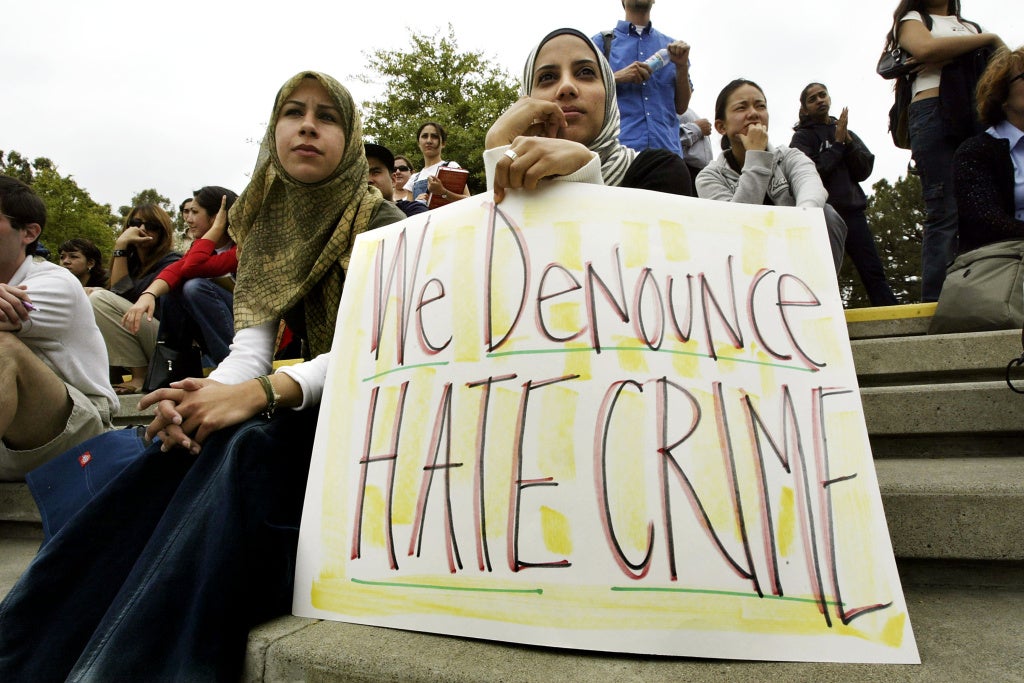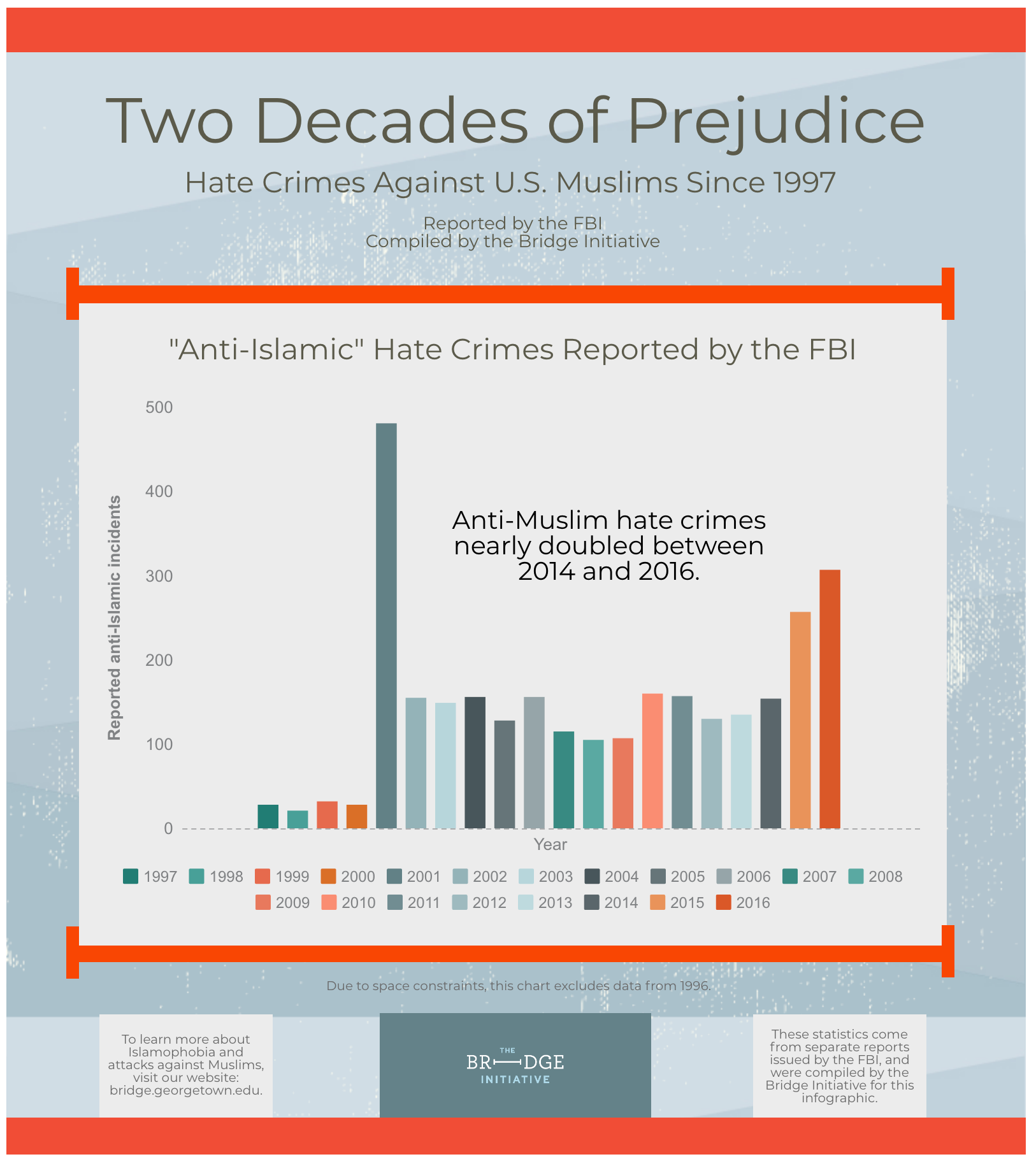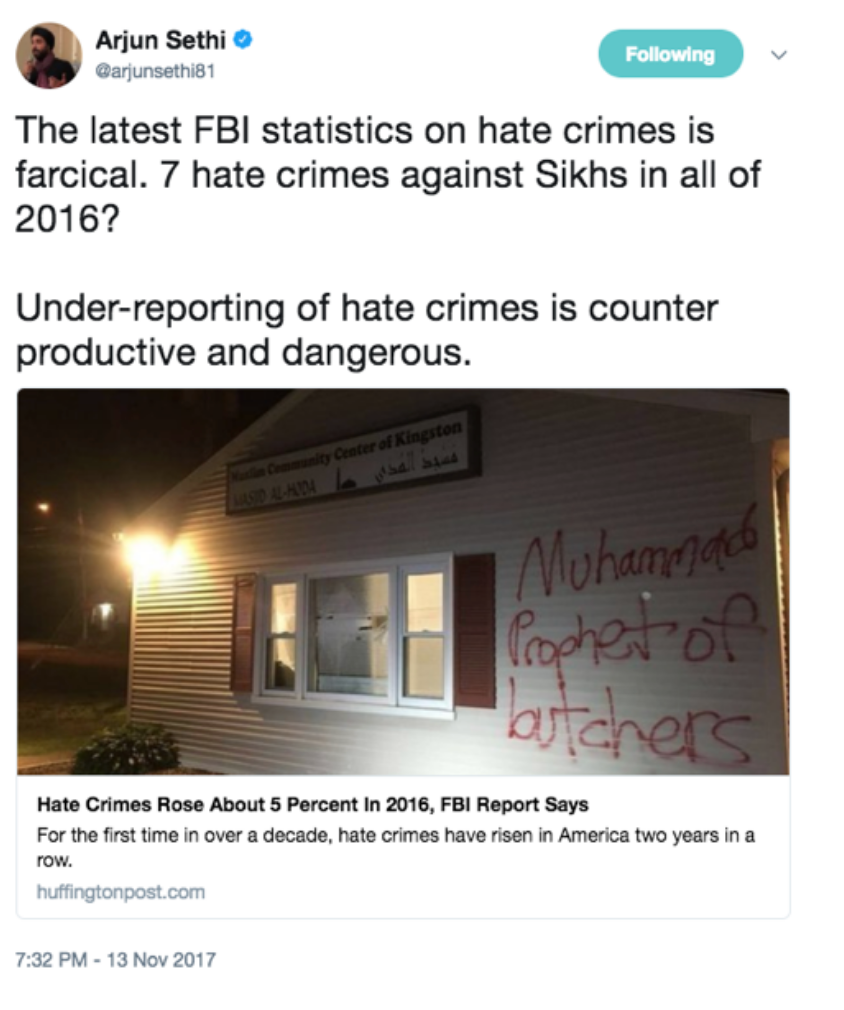
Image Source: DAVID MCNEW/GETTY IMAGES
Does Islamophobia Impact the Underreporting of FBI Hate Crime Data?
Federal Data Collection on Hate Crimes: A History
Since its first publication in 1991, the Federal Bureau of Investigation (FBI) has released an annual report on hate crime data. The FBI employs the hate crime definition as established in the Hate Crime Statistics Act, passed by the U.S. Congress in 1990: “crimes that manifest evidence of prejudice based on race, gender or gender identity, religion, disability, sexual orientation, or ethnicity.”
The sources of the FBI’s annual hate crime data are twofold: The Bureau of Justice Statistics’ (BJS) National Crime Victimization Survey (NCVS), and the FBI’s Uniform Crime Reporting (UCR) Hate Crime Statistics Program. The NCVS “measures crimes perceived by victims to be motivated by an offender’s bias against them for belonging to or being associated with a group largely identified by those characteristics.” Because NCVS is survivor-centric, however, murder animated by bias is not reported. By contrast, the UCR receives data from voluntarily participating law enforcement agencies around the country. UCR data, therefore, is law enforcement-centric and quite discretionary in terms of what law enforcement agencies do and do not classify as a hate crime. Additionally, since participating is not mandatory, not all agencies report data on hate crimes to the FBI.
In November 2017, the FBI released its data on hate crimes in 2016. The report observed that hate crimes increased by about 5% overall in 2016. According to analysis by the Pew Research Center, assaults against Muslims in 2016 in the U.S. surpassed those that occurred in 2001, the year of the World Trade Center and Pentagon attacks. Contextualizing the rise in reported hate crime data, journalist Ken Schwenke observed that hate crimes reported during the fourth quarter of 2016 “the months of October through December ” had increased by 25.9% from 2015. Notably, the U.S. presidential elections took place in November 2016.
Infographic featuring 20 years of FBI Hate Crime Data compiled by the Bridge Initiative
Complicating these data, however, is the fact that reported incidents of hate crimes are severely underreported. According to the Lawyers’ Committee for Civil Rights Under Law, “the public record of hate crimes is notoriously low compared to the on the ground reality.” In 2016, just 1,776 or 11.6% of participating law enforcement agencies in 2016 reported that any hate crimes had occurred in their locales. Which means that 88.4% of participating law enforcement agencies reported that zero hate crimes had occurred. Furthermore, hate crime statutes and protected classes (i.e. gender, sexual orientation, gender identity, disability) vary state to state, and not every state even has a hate crime law (five total do not: Arkansas, Georgia, Indiana, South Carolina, and Wyoming).[1]
So, why are hate crime data so underreported? The reasons are twofold, in that both individuals and law enforcement agents underreport hate crimes. The next sections will examine the reasons for this underreporting, and the extent to which Islamophobia plays a role.
Why Do Individuals Underreport Hate Crimes?
The current climate is rife with countless reports of interpersonal violence animated by anti-Muslim prejudice and bigotry. Arguably, anti-Muslim laws and policies that institutionalize Islamophobia into our legal, political and judicial structures play a role in bolstering such violence. Moreover, various anti-Muslim law enforcement and intelligence gathering activities play a cumulative effect in eroding community and individual trust or confidence in law enforcement agencies. In fact, as explicated in a June 2017 BJS report, in which survivors of “hate crime victimization” were asked why they did not report hate crimes to police, approximately a quarter (23%) responded: “police would not want to be bothered or to get involved, would be inefficient or ineffective, or would cause trouble for the victim.”
For many Muslims, the domestic War on Terror apparatus, such as targeted surveillance, the planting of informants in communities, and religio-racial profiling by FBI and law enforcement according to prevailing “counterterror“ and “countering violent extremism“ (CVE) programs present serious concerns to hate crime reporting. Having an illegalized immigration status can also prevent hate crime survivors from reporting to law enforcement, out of fear of potential detention and/or deportation. For survivors of hate crimes that identify as LGBTQIA+, the fear of outing oneself can also prevent reporting. And with countless incidents of so-called “wrongful deaths” and police brutality and against Black, disabled and/or Native people in the United States, survivors of hate crimes that identify accordingly may think twice before reporting a hate crime. Moreover, myriad ways in which these identities intersect can compound survivors’ fear and reluctance to report hate crimes to law enforcement.
Why Do Law Enforcement Agencies Underreport Hate Crimes?
According to a November 2017 report by ProPublica, hate crime underreporting by law enforcement is primarily due to a severe lack of training on hate crime laws. The report details, for instance, that only 12 states have statutes that require police academies to teach prospective police officers about hate crimes. Additionally, at least seven states (Alaska, Georgia, Idaho, Nevada, Missouri, South Dakota and Texas) have no requirements for law enforcement hate crime training whatsoever. Of the states that do provide training, officials in Wisconsin, North Carolina and Washington reported that recruits spend approximately 30 minutes total on hate crime instruction. In Alaska, state officials were not aware that Alaska even had a hate crime statute, and in Kansas, training materials made no mention of the state’s hate crime statute.
In addition to systemic undertraining with regards to hate crime laws, anti-Muslim law enforcement workshops, speakers and training materials have long been an issue in the U.S. In particular, the groundbreaking story in 2011 by Spencer Ackerman in Wired revealed a systemic anti-Muslim bias in “counterterrorism” training within the U.S. government.
The Obama Administration cited Ackerman’s report in a memorandum that mandated a federal agency-wide review of all “government counterterrorism training materials.” The review resulted in the purge of countless documents and training materials that contained anti-Muslim bias.
According to one such FBI training material, in the form of a PowerPoint presentation, racist, alarmist and breathtakingly reductive information was presented to federal agents, such as:
- Islam “transforms country’s [sic] culture into 7th century Arabian ways.”
- “9,000+ Muslims on active duty in the U.S. armed services”
- “It is characteristic of the Arab mind to be swayed more by words than ideas and more by ideas than facts.”
The presentation also recommended reading materials, including two books by Robert Spencer, who the Center for American Progress’ “Fear Inc.” report describes as “the primary driver in promoting the myth that peaceful Islam is nonexistent and that violent extremism is inherent within traditional Islam.” (It should also be noted that while the FBI cites Spencer in its training materials, he has been banned from the United Kingdom since 2013, along with Pamela Geller, for incitement to violence against Muslims.)
Spencer’s cited books include: The Politically Incorrect Guide to Islam (and the Crusades) and The Truth About Muhammad: Founder of the World’s Most Intolerant Religion. The training material also recommended The Arab Mind by Raphael Patai, which reporting in Slate described as “rel[ying] so heavily on generalizations and statistics that it represents the Arab world as one inhabited by automatons who simply enact the roles that their culture and climate have designed for them.”
Despite this review and purge of anti-Muslim materials, the U.S. government did not implement meaningful, long-term reforms or mechanisms for transparency. According to Muslim Advocates: “No public accounting was given indicating that the more comprehensive inter-agency review was initiated as promised, no re-training of officers and agents tainted by the biased and inaccurate trainings was apparently ever done, and no disciplinary action appears to have been taken against those responsible for preparing and providing the trainings.”
Perhaps unsurprisingly, then, anti-Muslim military and law enforcement trainings continue. In 2013, for instance, The Washington Post published National Security Agency training manuals that instructed analysts to search its databases with placeholder queries like “Mohammad Badguy” and “Muhammad Fake Name.” And in 2014, The Intercept reported that the U.S. government had been surveilling Muslim community leaders, publishing template documents used by the FBI and National Security Agency. The templates listed “Mohammed Raghead” as the placeholder name for potential surveillance targets.
More recently, in December 2016, the President of the National Sheriff’s Association encouraged sheriffs to attend trainings by an organization called Understanding the Threat (UTT), an outfit founded by former FBI agent John Guandolo. According to its website, UTT seeks to train law enforcement on understanding the “jihadi networks in communities around the nation” and to provide “a detailed understanding of street violence emerging from the alliance among the Muslim Brotherhood and violent anarchist groups including Black Lives Matter.”
As reported by the Center for New Community (CNC), UTT’s training materials are “steeped in anti-Muslim conspiracy theories and vilify Muslim community members.” By contrast, the National Sheriff’s Association President described UTT’s trainings as “the only training program for law enforcement in the nation which actually gives officers ways to proactively find terrorists in their communities, map out the terrorist network in the community, and create innovative investigative strategies to aggressively tackle the threat at the local level.”
The preponderance of anti-Muslim workshops, speakers and training materials premised on Islamophobic junk science (i.e. racist generalizations about the “Arab mind”), conspiracies and outright falsehoods about Islam and Muslims reveal a disturbing pattern of anti-Muslim bias in law enforcement. And, such bias is bound to impact law enforcement policing, investigating and hate crime reporting. In fact, according to a 2011 report by Political Research Associates, religious and racial bias in law enforcement training could result in “police officers being more likely to shoot in an ambiguous situation” and “more assaults against people identified rightly or wrongly as Muslim or Arab.” The report also concludes that biased trainings “may cause law enforcement executives or officers to doubt and under-investigate complaints of hate crimes or civil rights violations from members of Muslim, Arab, Middle Eastern, and South Asian communities.”
Moreover, the FBI’s Uniform Crime Reporting (UCR) Program, which oversees hate crime reporting, lends itself to a bureaucratic structure in which some individuals on its advisory board exhibit troubling track records with regards to hate crime investigations and possible anti-Muslim and anti-Black bias. Some of these current advisory board members include Jonathan Thompson, the current Executive Director of the National Sheriffs’ Association, and John Donohue, Assistant Chief, Executive Officer, Intelligence Bureau, New York City Police Department.
Jonathan Thompson, Director of the National Sheriffs’ Association
In June 2017, anti-Muslim law enforcement trainer John Guandolo faced charges for physically assaulting a sheriff at a National Sheriff’s Association gathering in Reno, Nevada (at which Guandolo was a presenter). Guandolo had previously written about the sheriff he assaulted, claiming that he “works with jihadis in the community” due to the presence of mosques in his county and for refusing briefings from Guandolo’s anti-Muslim training organization. Following the assault, the NSA Executive Director Jonathan Thompson, who is on the FBI’s UCR advisory board, released a message to NSA members condemning Gunadolo’s organization. As pointed out by CNC, however, Thompson’s message “omit[s] the fact that Guandolo and UTT have presented at NSA events this year under his executive directorship.” Moreover, CNC reports that the NSA has also “collaborated with known anti-immigrant groups like the Federation for American Immigration Reform (FAIR).”
John Donohue, Assistant Chief, Executive Officer, Intelligence Bureau, NYC Police Department
In February 2017, a Manhattan Supreme Court justice ruled that the NYPD “must disclose their surveillance of Black Lives Matter protests” in Grand Central Station dating back to 2014 and 2015. As reported in Essence, “Department officials were reportedly determined not to release the information with the argument that protesters might be connected to the Islamic State.” In an affidavit by NYPD’s assistant intelligence chief John Donahue, who is on the FBI’s UCR advisory board, Donohue argued that releasing the records could reveal “the kinds of optical technology NYPD uses, both in its undercover and general surveillance operations,” in addition to “any areas NYPD does not have under surveillance, thereby exposing gaps in coverage.”
It should be noted that in 2015, Muslim Advocates with the Center for Constitutional Rights won a groundbreaking appeal against the NYPD for “blanket, suspicionless surveillance” against Muslim communities in New Jersey. A settlement was reached in an additional case brought forward by the ACLU and other organizations on behalf of individuals and institutions in Brooklyn that were “subject to the NYPD’s unconstitutional religious profiling program.”
These examples demonstrate that, on top of and in addition to widespread anti-Muslim and anti-Islam bias in law enforcement agencies and the FBI, the very reporting mechanism of federal hate crime data, and some of its advisors in particular, are susceptible to potential anti-Muslim and anti-Islam bias.
While big picture patterns of FBI’s hate crime data are illuminating, it is critical to contextualize the data by understanding the non-mandatory reporting mechanisms, systemic anti-Muslim law enforcement training materials and speakers, and the mistrust that many Muslim communities have in law enforcement. Doing so reveals how Islamophobia continues to become deeply entrenched in U.S. policing, surveillance and intelligence gathering activities, and how hate crime underreporting by law enforcement agencies is symptomatic of systemic hate crime undertraining and deep-seated anti-Muslim and anti-Islam bias.
[1] For more information regarding hate crime laws at the state level, reference the Lawyers’ Committee for Civil Rights Under Law’s “Stop Hate Project,” which provides online material and an interactive map.

 Search
Search
